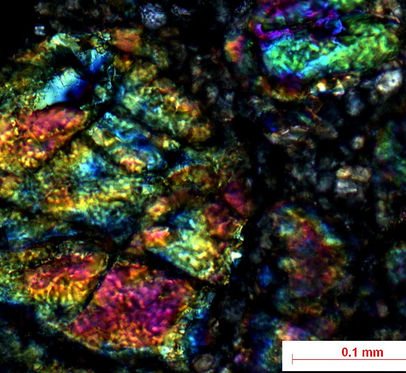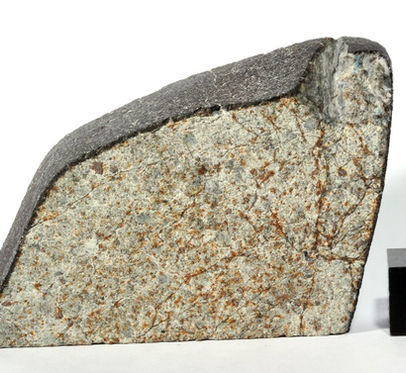top of page
TRÊS IRMÃOS
Stony
TYPE:
CLASS:
CLAN:
GROUP:
SUBGROUP:
TYPE PET:
SHOCK STG:
WEATHERING:
COUNTRY:
YEAR:
DESCRIPTION:
CHONDRITE
ORDINARY
H-L-LL
L
-
6
S3
W0
BRAZIL - BA
2017
Equilibrated Ordinary chondrite L6, Shock Stage S3, no Weathering (W0).
PETROGRAPHY:
(M. E. Zucolotto, MNRJ and C. Villaça, IGEO/UFRJ) Polished thin and microprobe sections show a high degree of recrystallization of the matrix with few recognizable chondrules. Plagioclase grains are abundant and exceed 50 μm in size. Metal grains include kamacite, zoned taenite and zoneless plessite. Monocrystalline chromite. The presence of melt pockets in addiction to irregular fractures in olivine and undulatory extinction of olivine and plagioclase indicate a shock stage of S3. Some thin veins cross the meteorite. No weathering products were observed.
GEOCHEMISTRY:
Electron microprobe analysis yielded: olivine Fa25.5±0.7 (Fa24.7-27.4; n=21), pyroxene Fs21.6±0.4Wo1.5±0.7 (Fs21.1-22.6Wo1.0-3.2; n=18).
CLASSIFICATION:
Equilibrated Ordinary chondrite L6, Shock Stage S3, no Weathering (W0).
CLASSIFIERS:
M.E. Zucolotto, A.A. Tosi and C.N. Villaça
HISTORY:
On May 26, 2017, about 11:30 am local time, a stone fell in the rural area of Palmas de Monte Alto, Bahia, Brazil. It was a clear sunny day; the residents heard some loud detonations, but thought it might be from a train line construction or a quarry. Mrs. Euzani Pais also heard a whistle and the sound of something hitting the soil. She went to the door and saw a small sand swirl. Her daughter and granddaughter, Sirlene da Silva Pais and Márcia Eduarda Pais, looked around and found a pit on the farm’s sandy road, with a black stone about 6 m away. A history professor, Nilton A. Azevedo, became aware of the fact and, with a broadcaster, published a video on the Internet. Andre L. R. Moutinho, M. E. Zucolotto (MNRJ) and Wilton Carvalho (GPA/UFBA leaded by Debora Rios) went to the site, certified the authenticity of the meteorite and purchased it in a consortium with the City Mayor on June 2. Physical characteristics: Single stone with dimensions 9 × 6 × 5 cm. Nearly completely covered by fusion crust with thickeness of 0.2-1 mm. On one edge, a piece of approx. 7 × 4 cm was sawed off, exposing the light-gray interior.
All information that does not have a specific source was extracted from the Meteoritical Bulletin Database.
All images are copyrighted.
bottom of page




